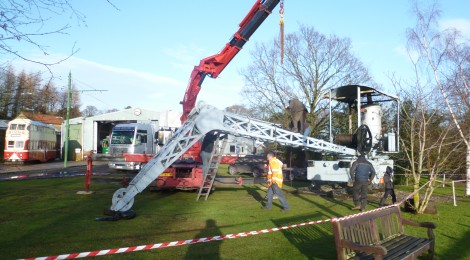
Transport & Industry News Mid February 2014…
After a few days leave here is the latest T&I news from Beamish. You may also notice some subtle changes to the Blog, part of a process of hopefully improving its appearance and the access to particular themes and topics. Let us know what you think!
Below: The Coles steam crane adjacent to the Tram Depot has departed for a new home at a museum in Cumbria. It was never an accessioned object at Beamish and came here as something of a last ditch effort to prevent it being scrapped. As a result, this Derby built and Bristol operated crane was placed on the nearest patch of land to the offices, where it has remained ever since! It will now be restored to steam to work in a timber yard, loading a steam powered rack saw. It is seen here with the jib lowered and a start being made on dismantling it last Saturday morning.
Below: The boiler was removed after the roof had been lifted clear.
Below: Preparing to load the underframe, with assorted crane bits all around!
Below: All packed and ready to depart.
Below: As part of the Home Farm re-dating to the Second World War period, several Anderson Shelters have been obtained, in order to create one good one! The bases tend to rot and the ends are almost always lost. As a result, Chris now has a pile of bits and a laborious patching exercise to create one shelter to original specification, which will be planted in the Orchard at Home Farm adjacent to the newly refurbished cottages.
Below: Some of the ‘spare’ bits – the straight sections being trimmed to form the new base of the shelter.
Below: Chris setting up and tack welding the patches. When the sections are cut short, they tend to flatten, so each piece has to be tacked and formed corrugation by corrugation to ensure it aligns with the main piece – fairly tedious work!
Below: Here is a new base, with sections tacked in place and which will be seam welded and ground flush.
Below: Dave has been hard at work on Samson, as ever! Here are the completed slidebars.
Below: Both slidebars have been hand scraped, as can be seen here, indicated by the gentle witness marks evident. This ensures an absolutely true surface. Note also the oil hole and rebate for lubricating the crosshead.
Below: This profile cut steel plate will form the connecting rod.
Below: Dave made this jig to set out the radius for the expansion link and die block, ensuring both are machined to match each other exactly.
Below: A close up of the expansion link (Samson has just the one).
Below: Another view of the jig, with die block in position for machining and the expansion link beyond.























Whats this i hear you have been offered the loco shed from Philadelpia?
Can I ask where abouts In cumbria the Coles steam crane is going?
Any news on the suggested Blackpool Trams mini gala?
Thanks
Rob
Hi Rob – I think the mini-gala will be the 1/2 March – should be able to confirm this tomorrow.
Paul – we haven’t! I had heard this elsewhere but it would be a tricky building to move and I think we heard it was built with cement rather than lime mortar. Cement makes for a very difficult deconstruction. We are often told we are having x or y building – often a ruse by developers to deflect attention away from a demolition by saying ‘its been offered to Beamish’. It has happened quite a few times, and has resulted in several myths around the buildings we have in store or plan to rebuild in the future…
Thanks for the reply and clarifiction. Hope somebody at your end is obtaining lintels etc from the Tyneside flats they are going to demolish in Gateshead. As i know its an aim to have some built on site.